Finance for Business: Financial Analysis of Emmerson Resources
VerifiedAdded on 2020/05/16
|17
|2700
|63
Report
AI Summary
This report presents a comprehensive financial analysis of Emmerson Resources, a prominent Australian mineral field holder. The analysis includes a detailed overview of the company's operations, ownership structure, and key personnel. It delves into the calculation of key financial ratios such as ROE, ROA, and debt-equity ratio, providing insights into the company's profitability and solvency. The report also utilizes data from the ASX website to analyze share price movements and compare them to market indices. Furthermore, it incorporates the Capital Asset Pricing Model (CAPM) to calculate beta and the required rate of return, offering a rationale for investment decisions. The Weighted Average Cost of Capital (WACC) is evaluated, and the debt ratio is examined to assess the company's capital structure. The report also discusses the dividend policy and concludes with a letter of recommendation to a client, summarizing the investment potential and future prospects of Emmerson Resources.
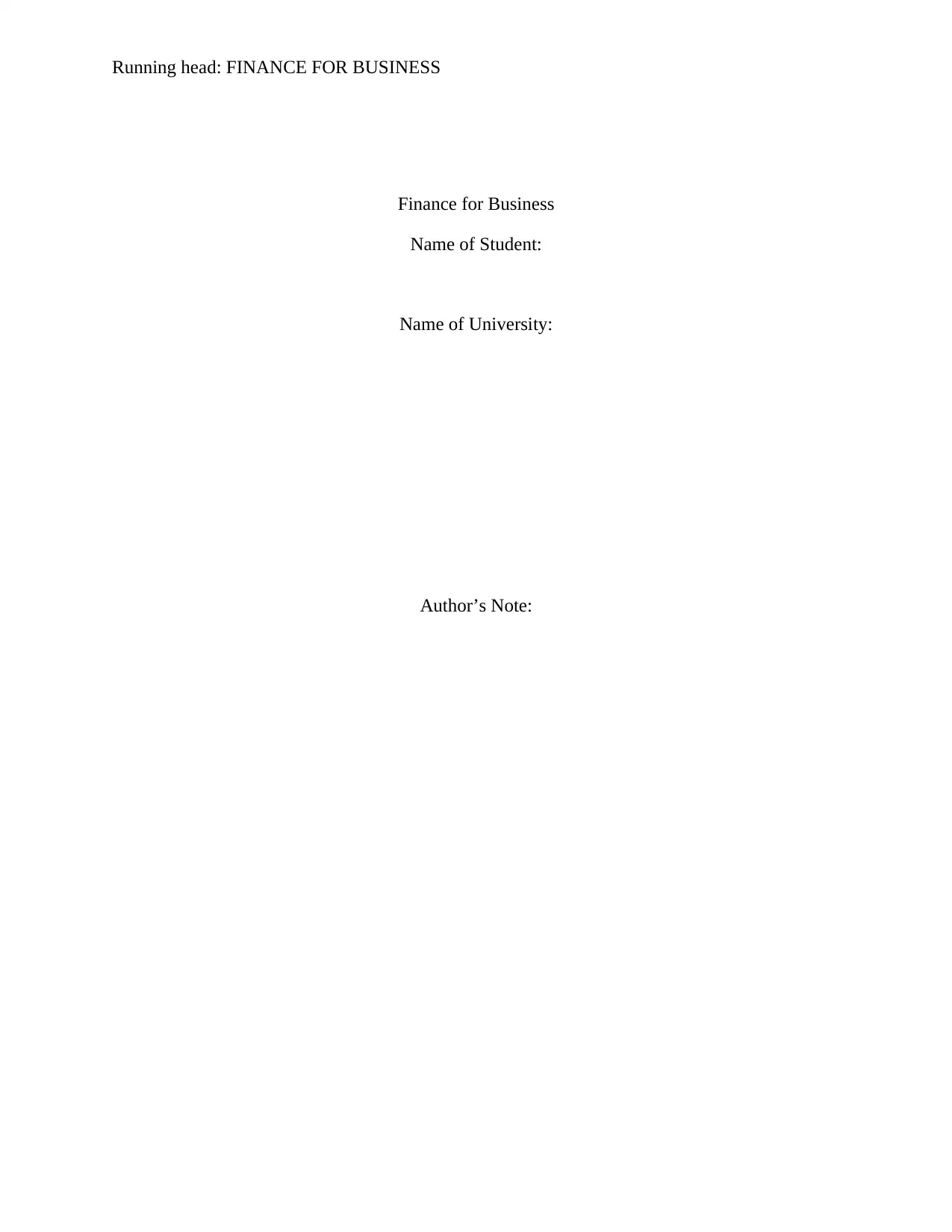
Running head: FINANCE FOR BUSINESS
Finance for Business
Name of Student:
Name of University:
Author’s Note:
Finance for Business
Name of Student:
Name of University:
Author’s Note:
Paraphrase This Document
Need a fresh take? Get an instant paraphrase of this document with our AI Paraphraser

1FINANCE FOR BUSINESS
Table of Contents
Introduction......................................................................................................................................3
1. Brief description of the company............................................................................................3
2. Ownership-governance structure.............................................................................................3
i. Substantial shareholders.......................................................................................................3
ii. The main people involved....................................................................................................4
3. Calculation of Key Ratios........................................................................................................4
i. Ratio Calculation..................................................................................................................4
ii. TA/OE Impacting on the relationship between ROA and ROE...........................................6
iii. Rationale for ROE significantly greater than ROA..........................................................6
4. Using the information from the ASX website.........................................................................7
i. Graph for movements in the monthly share price over the last two years...........................7
ii. Comparison of movements in the companies’ share price index.........................................7
5. Research via the internet or financial/business publications...................................................7
6. Capital Asset Pricing Model....................................................................................................8
i. Calculated beta (β) for the company.....................................................................................8
ii. Rate of return for the companies’ shares..............................................................................9
iii. Rationale for conservative investment............................................................................10
7. Weighted Average Cost of Capital (WACC)........................................................................10
i. WACC Calculation.............................................................................................................10
Table of Contents
Introduction......................................................................................................................................3
1. Brief description of the company............................................................................................3
2. Ownership-governance structure.............................................................................................3
i. Substantial shareholders.......................................................................................................3
ii. The main people involved....................................................................................................4
3. Calculation of Key Ratios........................................................................................................4
i. Ratio Calculation..................................................................................................................4
ii. TA/OE Impacting on the relationship between ROA and ROE...........................................6
iii. Rationale for ROE significantly greater than ROA..........................................................6
4. Using the information from the ASX website.........................................................................7
i. Graph for movements in the monthly share price over the last two years...........................7
ii. Comparison of movements in the companies’ share price index.........................................7
5. Research via the internet or financial/business publications...................................................7
6. Capital Asset Pricing Model....................................................................................................8
i. Calculated beta (β) for the company.....................................................................................8
ii. Rate of return for the companies’ shares..............................................................................9
iii. Rationale for conservative investment............................................................................10
7. Weighted Average Cost of Capital (WACC)........................................................................10
i. WACC Calculation.............................................................................................................10
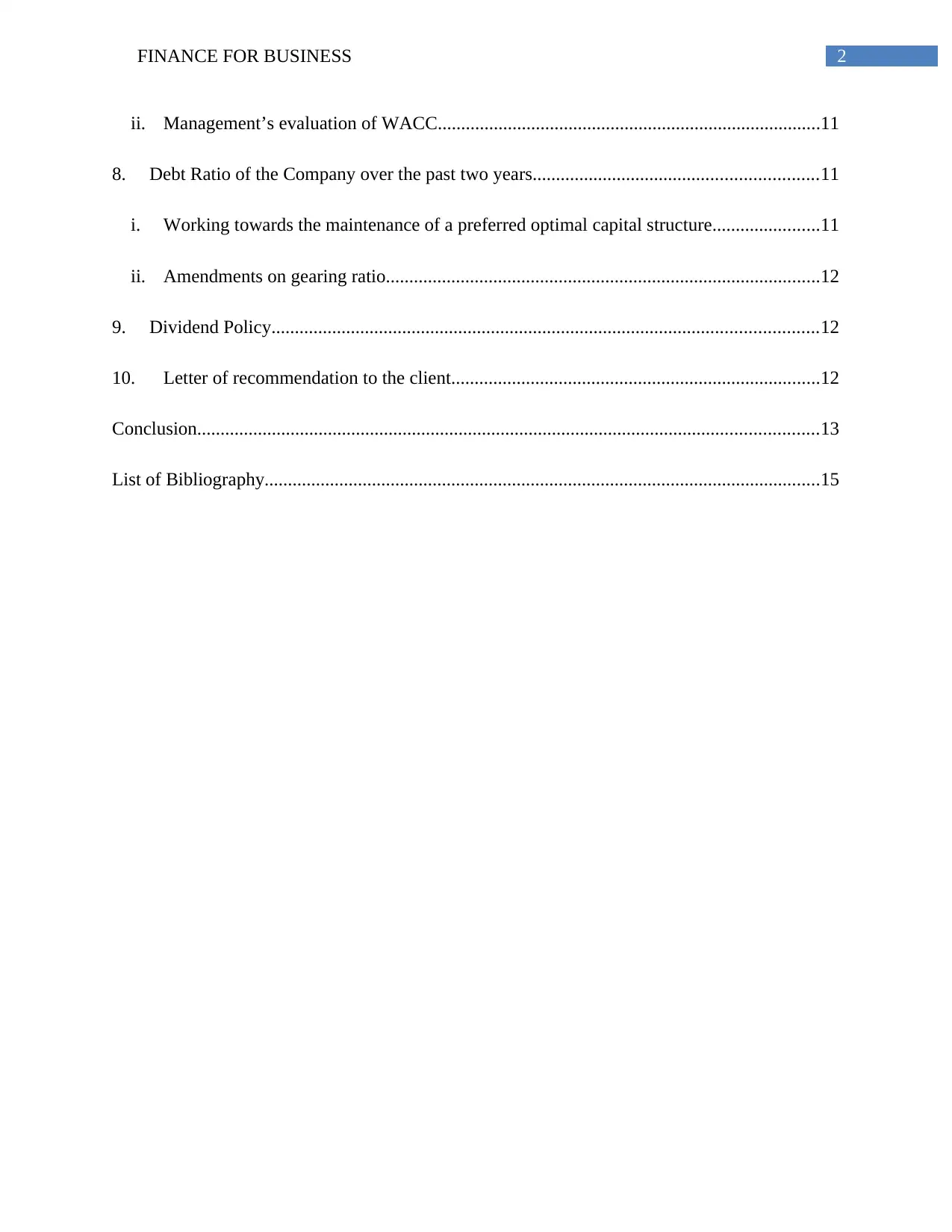
2FINANCE FOR BUSINESS
ii. Management’s evaluation of WACC..................................................................................11
8. Debt Ratio of the Company over the past two years.............................................................11
i. Working towards the maintenance of a preferred optimal capital structure.......................11
ii. Amendments on gearing ratio.............................................................................................12
9. Dividend Policy.....................................................................................................................12
10. Letter of recommendation to the client...............................................................................12
Conclusion.....................................................................................................................................13
List of Bibliography.......................................................................................................................15
ii. Management’s evaluation of WACC..................................................................................11
8. Debt Ratio of the Company over the past two years.............................................................11
i. Working towards the maintenance of a preferred optimal capital structure.......................11
ii. Amendments on gearing ratio.............................................................................................12
9. Dividend Policy.....................................................................................................................12
10. Letter of recommendation to the client...............................................................................12
Conclusion.....................................................................................................................................13
List of Bibliography.......................................................................................................................15
⊘ This is a preview!⊘
Do you want full access?
Subscribe today to unlock all pages.

Trusted by 1+ million students worldwide
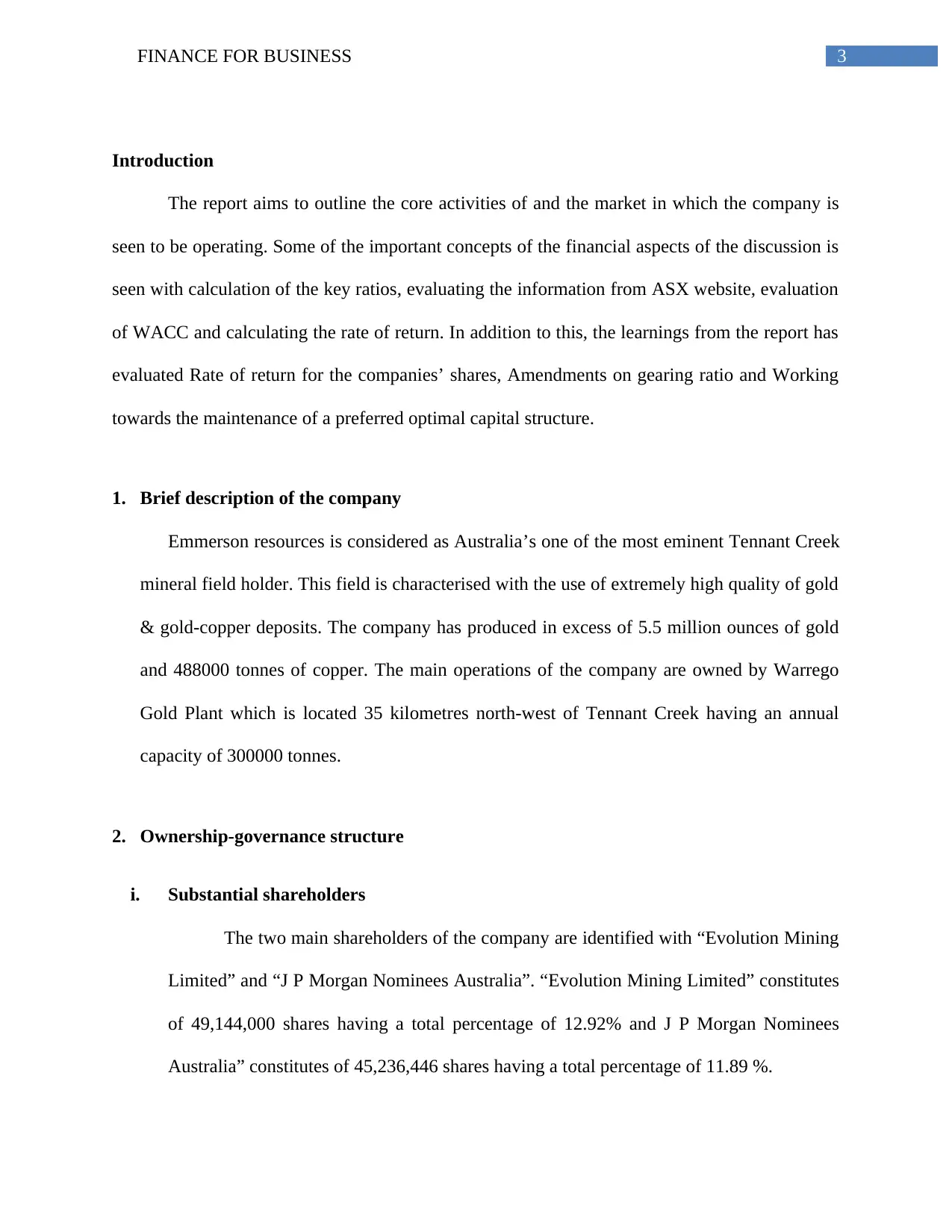
3FINANCE FOR BUSINESS
Introduction
The report aims to outline the core activities of and the market in which the company is
seen to be operating. Some of the important concepts of the financial aspects of the discussion is
seen with calculation of the key ratios, evaluating the information from ASX website, evaluation
of WACC and calculating the rate of return. In addition to this, the learnings from the report has
evaluated Rate of return for the companies’ shares, Amendments on gearing ratio and Working
towards the maintenance of a preferred optimal capital structure.
1. Brief description of the company
Emmerson resources is considered as Australia’s one of the most eminent Tennant Creek
mineral field holder. This field is characterised with the use of extremely high quality of gold
& gold-copper deposits. The company has produced in excess of 5.5 million ounces of gold
and 488000 tonnes of copper. The main operations of the company are owned by Warrego
Gold Plant which is located 35 kilometres north-west of Tennant Creek having an annual
capacity of 300000 tonnes.
2. Ownership-governance structure
i. Substantial shareholders
The two main shareholders of the company are identified with “Evolution Mining
Limited” and “J P Morgan Nominees Australia”. “Evolution Mining Limited” constitutes
of 49,144,000 shares having a total percentage of 12.92% and J P Morgan Nominees
Australia” constitutes of 45,236,446 shares having a total percentage of 11.89 %.
Introduction
The report aims to outline the core activities of and the market in which the company is
seen to be operating. Some of the important concepts of the financial aspects of the discussion is
seen with calculation of the key ratios, evaluating the information from ASX website, evaluation
of WACC and calculating the rate of return. In addition to this, the learnings from the report has
evaluated Rate of return for the companies’ shares, Amendments on gearing ratio and Working
towards the maintenance of a preferred optimal capital structure.
1. Brief description of the company
Emmerson resources is considered as Australia’s one of the most eminent Tennant Creek
mineral field holder. This field is characterised with the use of extremely high quality of gold
& gold-copper deposits. The company has produced in excess of 5.5 million ounces of gold
and 488000 tonnes of copper. The main operations of the company are owned by Warrego
Gold Plant which is located 35 kilometres north-west of Tennant Creek having an annual
capacity of 300000 tonnes.
2. Ownership-governance structure
i. Substantial shareholders
The two main shareholders of the company are identified with “Evolution Mining
Limited” and “J P Morgan Nominees Australia”. “Evolution Mining Limited” constitutes
of 49,144,000 shares having a total percentage of 12.92% and J P Morgan Nominees
Australia” constitutes of 45,236,446 shares having a total percentage of 11.89 %.
Paraphrase This Document
Need a fresh take? Get an instant paraphrase of this document with our AI Paraphraser
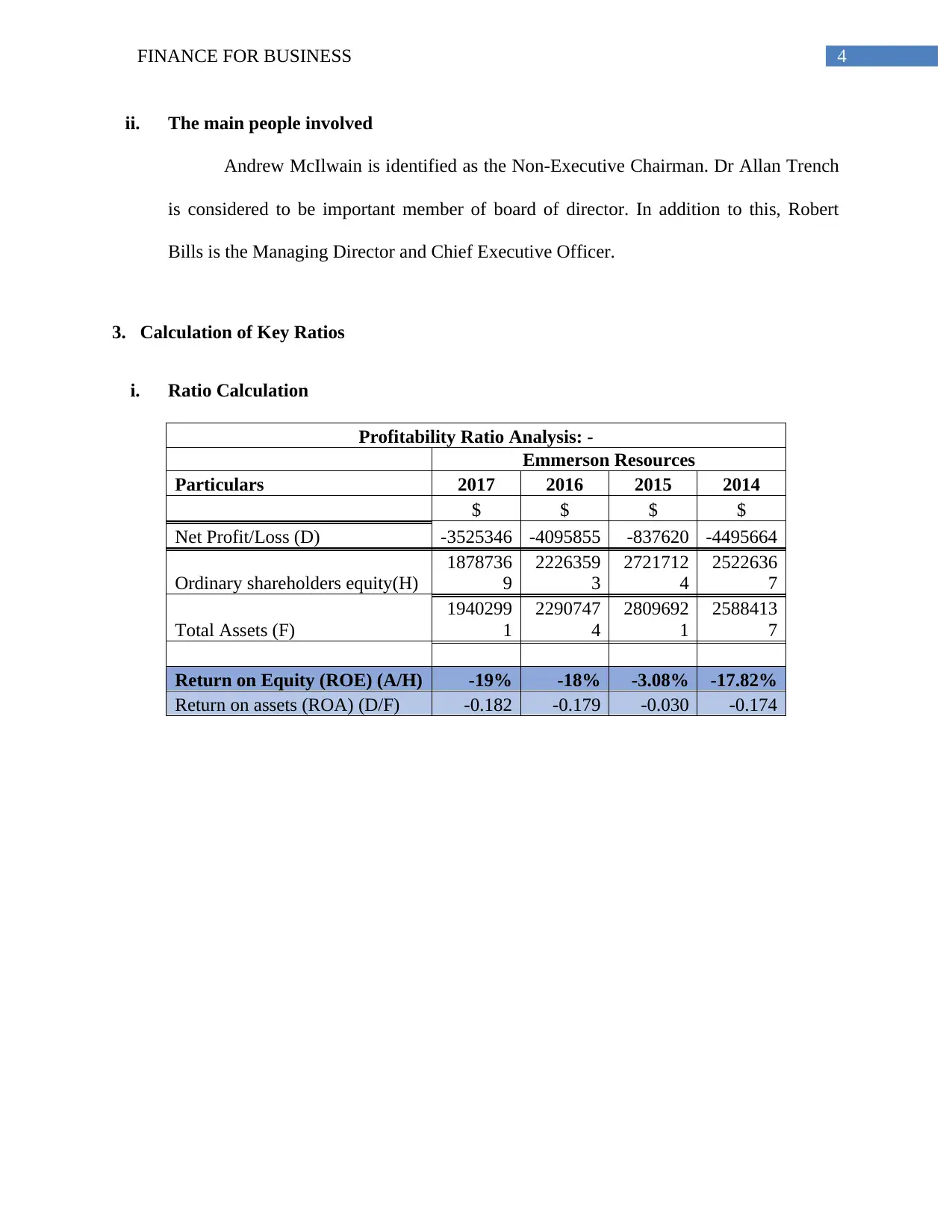
4FINANCE FOR BUSINESS
ii. The main people involved
Andrew McIlwain is identified as the Non-Executive Chairman. Dr Allan Trench
is considered to be important member of board of director. In addition to this, Robert
Bills is the Managing Director and Chief Executive Officer.
3. Calculation of Key Ratios
i. Ratio Calculation
Profitability Ratio Analysis: -
Emmerson Resources
Particulars 2017 2016 2015 2014
$ $ $ $
Net Profit/Loss (D) -3525346 -4095855 -837620 -4495664
Ordinary shareholders equity(H)
1878736
9
2226359
3
2721712
4
2522636
7
Total Assets (F)
1940299
1
2290747
4
2809692
1
2588413
7
Return on Equity (ROE) (A/H) -19% -18% -3.08% -17.82%
Return on assets (ROA) (D/F) -0.182 -0.179 -0.030 -0.174
ii. The main people involved
Andrew McIlwain is identified as the Non-Executive Chairman. Dr Allan Trench
is considered to be important member of board of director. In addition to this, Robert
Bills is the Managing Director and Chief Executive Officer.
3. Calculation of Key Ratios
i. Ratio Calculation
Profitability Ratio Analysis: -
Emmerson Resources
Particulars 2017 2016 2015 2014
$ $ $ $
Net Profit/Loss (D) -3525346 -4095855 -837620 -4495664
Ordinary shareholders equity(H)
1878736
9
2226359
3
2721712
4
2522636
7
Total Assets (F)
1940299
1
2290747
4
2809692
1
2588413
7
Return on Equity (ROE) (A/H) -19% -18% -3.08% -17.82%
Return on assets (ROA) (D/F) -0.182 -0.179 -0.030 -0.174
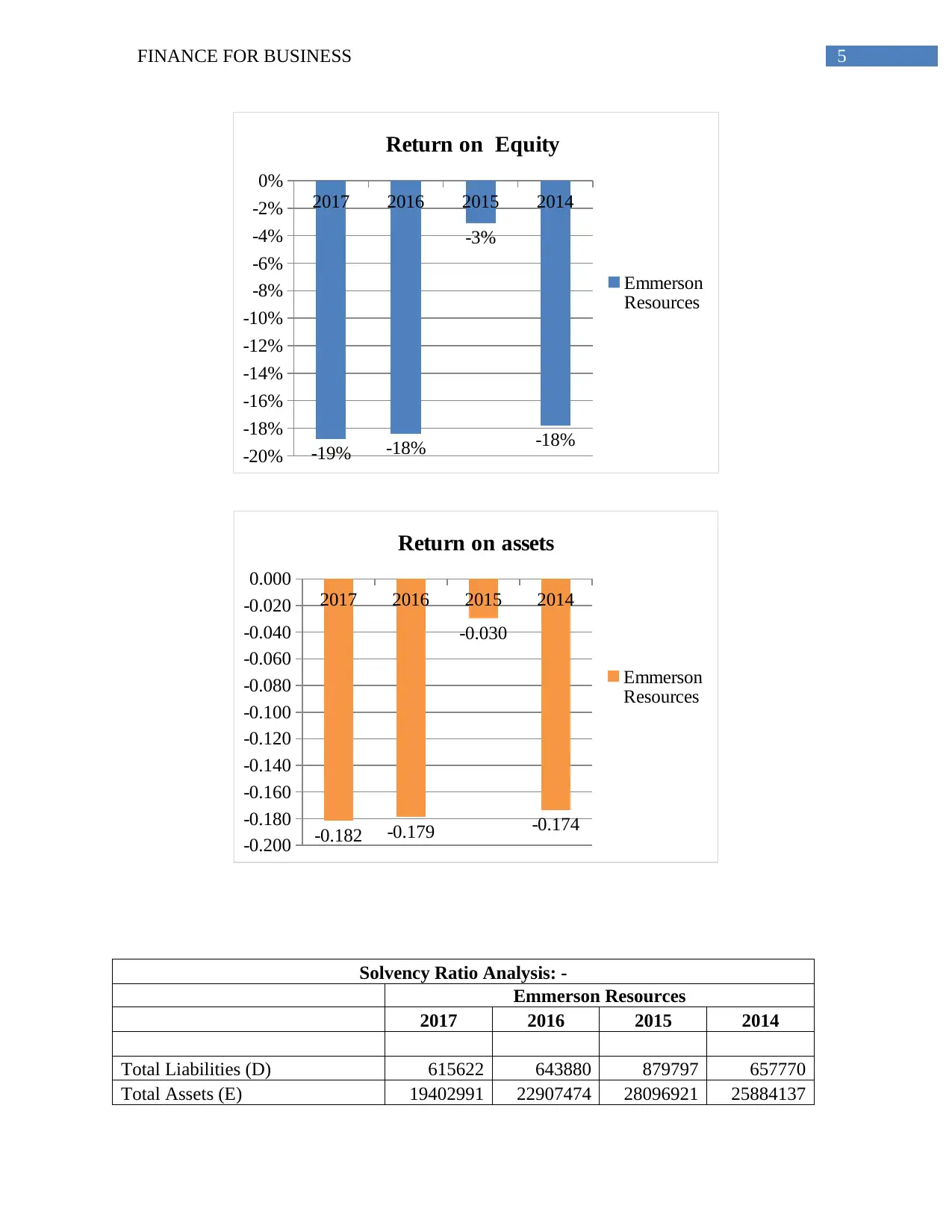
5FINANCE FOR BUSINESS
2017 2016 2015 2014
-20%
-18%
-16%
-14%
-12%
-10%
-8%
-6%
-4%
-2%
0%
-19% -18%
-3%
-18%
Return on Equity
Emmerson
Resources
2017 2016 2015 2014
-0.200
-0.180
-0.160
-0.140
-0.120
-0.100
-0.080
-0.060
-0.040
-0.020
0.000
-0.182 -0.179
-0.030
-0.174
Return on assets
Emmerson
Resources
Solvency Ratio Analysis: -
Emmerson Resources
2017 2016 2015 2014
Total Liabilities (D) 615622 643880 879797 657770
Total Assets (E) 19402991 22907474 28096921 25884137
2017 2016 2015 2014
-20%
-18%
-16%
-14%
-12%
-10%
-8%
-6%
-4%
-2%
0%
-19% -18%
-3%
-18%
Return on Equity
Emmerson
Resources
2017 2016 2015 2014
-0.200
-0.180
-0.160
-0.140
-0.120
-0.100
-0.080
-0.060
-0.040
-0.020
0.000
-0.182 -0.179
-0.030
-0.174
Return on assets
Emmerson
Resources
Solvency Ratio Analysis: -
Emmerson Resources
2017 2016 2015 2014
Total Liabilities (D) 615622 643880 879797 657770
Total Assets (E) 19402991 22907474 28096921 25884137
⊘ This is a preview!⊘
Do you want full access?
Subscribe today to unlock all pages.

Trusted by 1+ million students worldwide
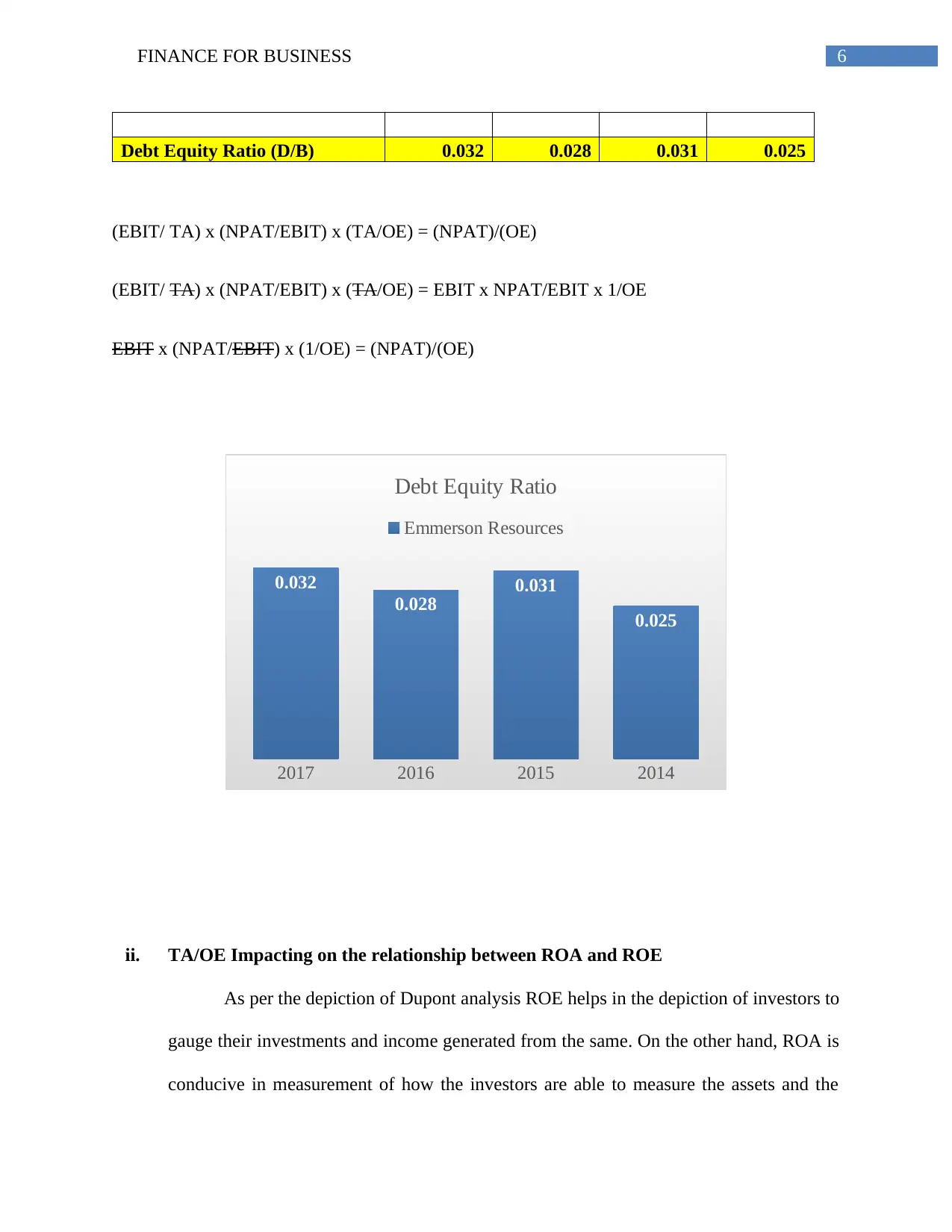
6FINANCE FOR BUSINESS
Debt Equity Ratio (D/B) 0.032 0.028 0.031 0.025
(EBIT/ TA) x (NPAT/EBIT) x (TA/OE) = (NPAT)/(OE)
(EBIT/ TA) x (NPAT/EBIT) x (TA/OE) = EBIT x NPAT/EBIT x 1/OE
EBIT x (NPAT/EBIT) x (1/OE) = (NPAT)/(OE)
2017 2016 2015 2014
0.032
0.028
0.031
0.025
Debt Equity Ratio
Emmerson Resources
ii. TA/OE Impacting on the relationship between ROA and ROE
As per the depiction of Dupont analysis ROE helps in the depiction of investors to
gauge their investments and income generated from the same. On the other hand, ROA is
conducive in measurement of how the investors are able to measure the assets and the
Debt Equity Ratio (D/B) 0.032 0.028 0.031 0.025
(EBIT/ TA) x (NPAT/EBIT) x (TA/OE) = (NPAT)/(OE)
(EBIT/ TA) x (NPAT/EBIT) x (TA/OE) = EBIT x NPAT/EBIT x 1/OE
EBIT x (NPAT/EBIT) x (1/OE) = (NPAT)/(OE)
2017 2016 2015 2014
0.032
0.028
0.031
0.025
Debt Equity Ratio
Emmerson Resources
ii. TA/OE Impacting on the relationship between ROA and ROE
As per the depiction of Dupont analysis ROE helps in the depiction of investors to
gauge their investments and income generated from the same. On the other hand, ROA is
conducive in measurement of how the investors are able to measure the assets and the
Paraphrase This Document
Need a fresh take? Get an instant paraphrase of this document with our AI Paraphraser
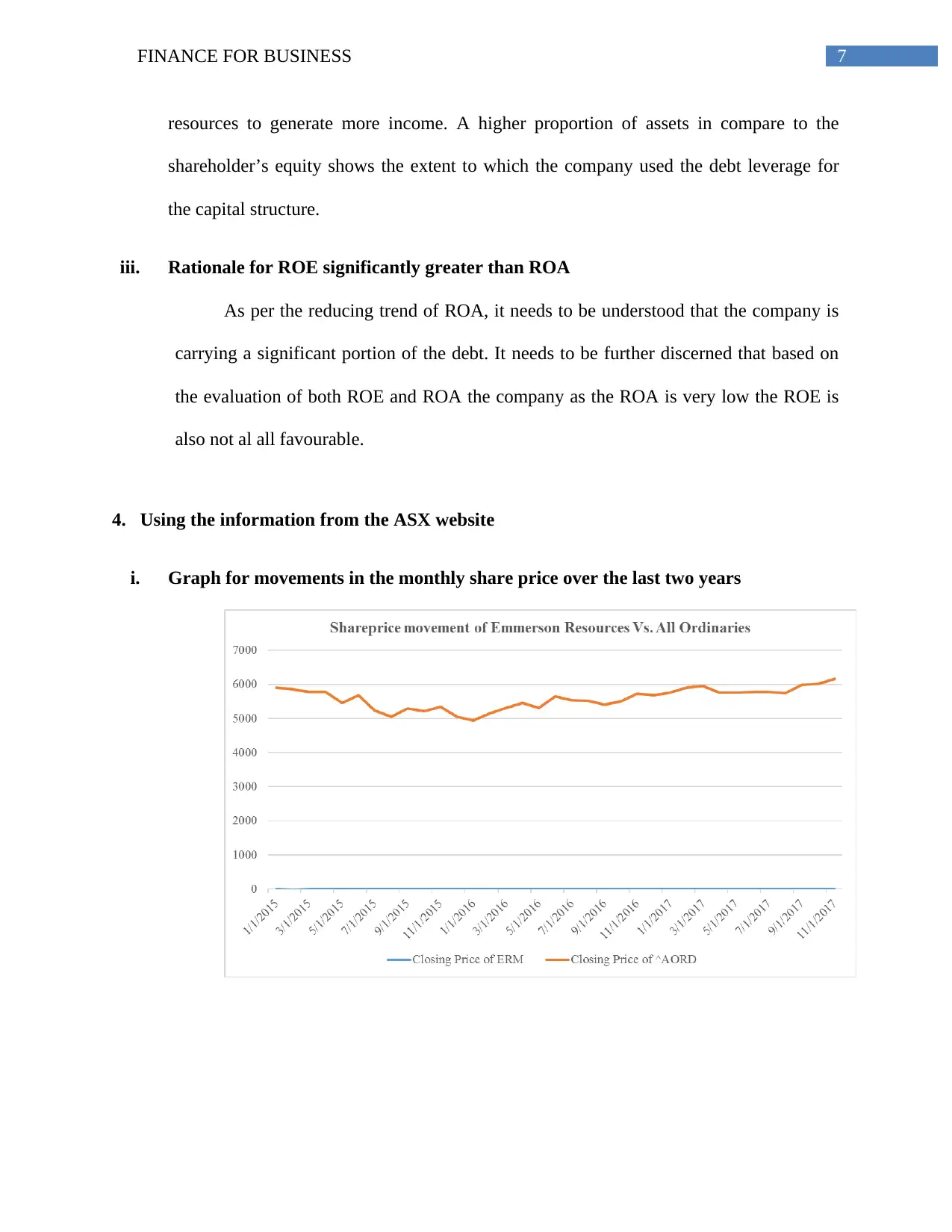
7FINANCE FOR BUSINESS
resources to generate more income. A higher proportion of assets in compare to the
shareholder’s equity shows the extent to which the company used the debt leverage for
the capital structure.
iii. Rationale for ROE significantly greater than ROA
As per the reducing trend of ROA, it needs to be understood that the company is
carrying a significant portion of the debt. It needs to be further discerned that based on
the evaluation of both ROE and ROA the company as the ROA is very low the ROE is
also not al all favourable.
4. Using the information from the ASX website
i. Graph for movements in the monthly share price over the last two years
resources to generate more income. A higher proportion of assets in compare to the
shareholder’s equity shows the extent to which the company used the debt leverage for
the capital structure.
iii. Rationale for ROE significantly greater than ROA
As per the reducing trend of ROA, it needs to be understood that the company is
carrying a significant portion of the debt. It needs to be further discerned that based on
the evaluation of both ROE and ROA the company as the ROA is very low the ROE is
also not al all favourable.
4. Using the information from the ASX website
i. Graph for movements in the monthly share price over the last two years
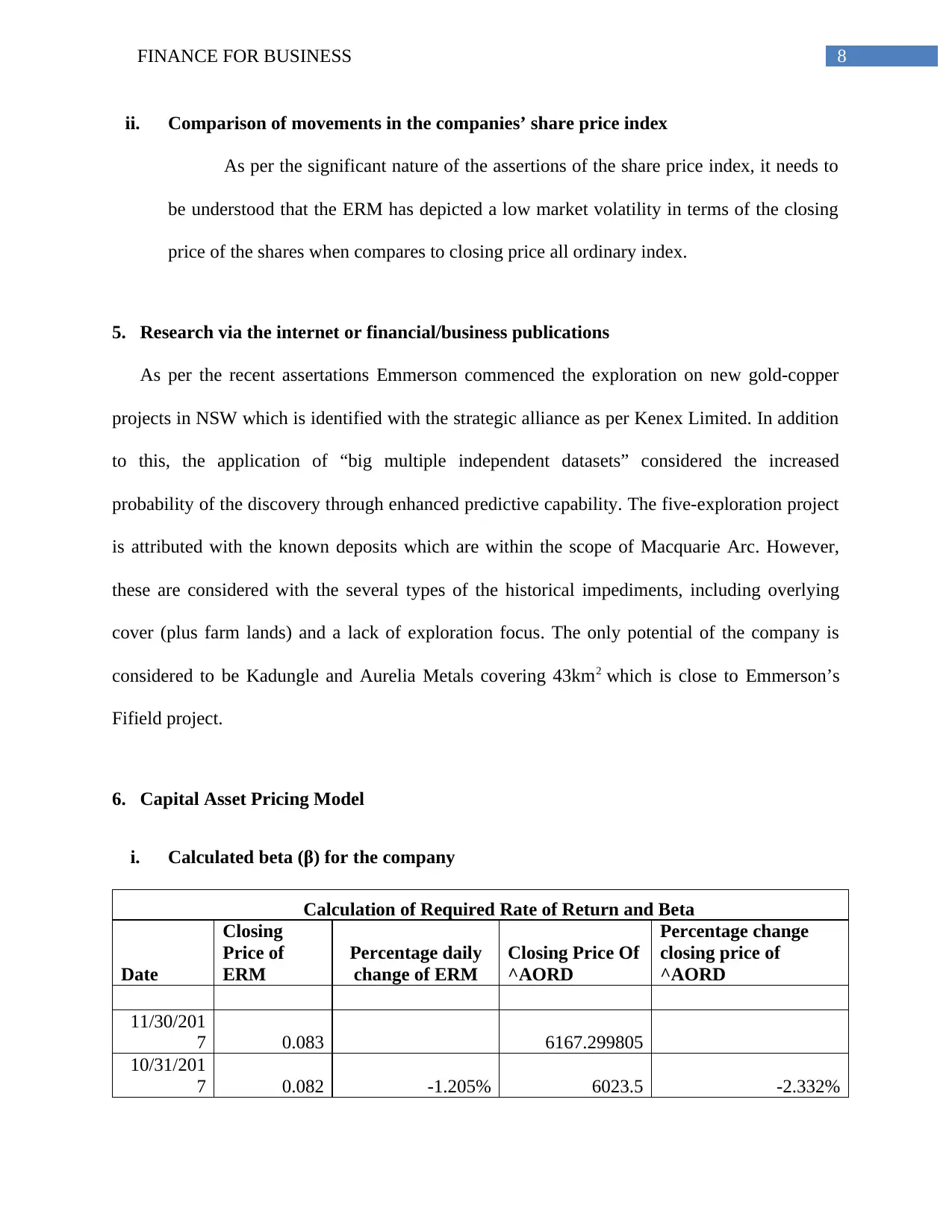
8FINANCE FOR BUSINESS
ii. Comparison of movements in the companies’ share price index
As per the significant nature of the assertions of the share price index, it needs to
be understood that the ERM has depicted a low market volatility in terms of the closing
price of the shares when compares to closing price all ordinary index.
5. Research via the internet or financial/business publications
As per the recent assertations Emmerson commenced the exploration on new gold-copper
projects in NSW which is identified with the strategic alliance as per Kenex Limited. In addition
to this, the application of “big multiple independent datasets” considered the increased
probability of the discovery through enhanced predictive capability. The five-exploration project
is attributed with the known deposits which are within the scope of Macquarie Arc. However,
these are considered with the several types of the historical impediments, including overlying
cover (plus farm lands) and a lack of exploration focus. The only potential of the company is
considered to be Kadungle and Aurelia Metals covering 43km2 which is close to Emmerson’s
Fifield project.
6. Capital Asset Pricing Model
i. Calculated beta (β) for the company
Calculation of Required Rate of Return and Beta
Date
Closing
Price of
ERM
Percentage daily
change of ERM
Closing Price Of
^AORD
Percentage change
closing price of
^AORD
11/30/201
7 0.083 6167.299805
10/31/201
7 0.082 -1.205% 6023.5 -2.332%
ii. Comparison of movements in the companies’ share price index
As per the significant nature of the assertions of the share price index, it needs to
be understood that the ERM has depicted a low market volatility in terms of the closing
price of the shares when compares to closing price all ordinary index.
5. Research via the internet or financial/business publications
As per the recent assertations Emmerson commenced the exploration on new gold-copper
projects in NSW which is identified with the strategic alliance as per Kenex Limited. In addition
to this, the application of “big multiple independent datasets” considered the increased
probability of the discovery through enhanced predictive capability. The five-exploration project
is attributed with the known deposits which are within the scope of Macquarie Arc. However,
these are considered with the several types of the historical impediments, including overlying
cover (plus farm lands) and a lack of exploration focus. The only potential of the company is
considered to be Kadungle and Aurelia Metals covering 43km2 which is close to Emmerson’s
Fifield project.
6. Capital Asset Pricing Model
i. Calculated beta (β) for the company
Calculation of Required Rate of Return and Beta
Date
Closing
Price of
ERM
Percentage daily
change of ERM
Closing Price Of
^AORD
Percentage change
closing price of
^AORD
11/30/201
7 0.083 6167.299805
10/31/201
7 0.082 -1.205% 6023.5 -2.332%
⊘ This is a preview!⊘
Do you want full access?
Subscribe today to unlock all pages.

Trusted by 1+ million students worldwide

9FINANCE FOR BUSINESS
9/30/2017 0.083 1.220% 5976.399902 -0.782%
8/31/2017 0.09 8.434% 5744.899902 -3.874%
7/31/2017 0.096 6.667% 5776.299805 0.547%
6/30/2017 0.11 14.583% 5773.899902 -0.042%
5/31/2017 0.1 -9.091% 5764 -0.171%
4/30/2017 0.09 -10.000% 5761.299805 -0.047%
3/31/2017 0.085 -5.556% 5947.600098 3.234%
2/28/2017 0.097 14.118% 5903.799805 -0.736%
1/31/2017 0.105 8.247% 5761 -2.419%
12/31/201
6 0.12 14.286% 5675 -1.493%
11/30/201
6 0.13 8.333% 5719.100098 0.777%
10/31/201
6 0.14 7.692% 5502.399902 -3.789%
9/30/2016 0.165 17.857% 5402.399902 -1.817%
8/31/2016 0.15 -9.091% 5525.200195 2.273%
7/31/2016 0.12 -20.000% 5529.399902 0.076%
6/30/2016 0.085 -29.167% 5644 2.073%
5/31/2016 0.049 -42.353% 5310.399902 -5.911%
4/30/2016 0.056 14.286% 5447.799805 2.587%
3/31/2016 0.047 -16.071% 5316 -2.419%
2/29/2016 0.04 -14.894% 5151.799805 -3.089%
1/31/2016 0.035 -12.500% 4947.899902 -3.958%
12/31/201
5 0.03 -14.286% 5056.600098 2.197%
11/30/201
5 0.037 23.333% 5344.600098 5.696%
10/31/201
5 0.04 8.108% 5218.200195 -2.365%
9/30/2015 0.054 35.000% 5288.600098 1.349%
8/31/2015 0.034 -37.037% 5058.600098 -4.349%
7/31/2015 0.032 -5.882% 5222.100098 3.232%
6/30/2015 0.032 0.000% 5681.700195 8.801%
5/31/2015 0.028 -12.500% 5451.200195 -4.057%
4/30/2015 0.03 7.143% 5774.899902 5.938%
3/31/2015 0.034 13.333% 5773.700195 -0.021%
2/28/2015 0.026 -23.529% 5861.899902 1.528%
1/31/2015 0.03 15.385% 5898.5 0.624%
9/30/2017 0.083 1.220% 5976.399902 -0.782%
8/31/2017 0.09 8.434% 5744.899902 -3.874%
7/31/2017 0.096 6.667% 5776.299805 0.547%
6/30/2017 0.11 14.583% 5773.899902 -0.042%
5/31/2017 0.1 -9.091% 5764 -0.171%
4/30/2017 0.09 -10.000% 5761.299805 -0.047%
3/31/2017 0.085 -5.556% 5947.600098 3.234%
2/28/2017 0.097 14.118% 5903.799805 -0.736%
1/31/2017 0.105 8.247% 5761 -2.419%
12/31/201
6 0.12 14.286% 5675 -1.493%
11/30/201
6 0.13 8.333% 5719.100098 0.777%
10/31/201
6 0.14 7.692% 5502.399902 -3.789%
9/30/2016 0.165 17.857% 5402.399902 -1.817%
8/31/2016 0.15 -9.091% 5525.200195 2.273%
7/31/2016 0.12 -20.000% 5529.399902 0.076%
6/30/2016 0.085 -29.167% 5644 2.073%
5/31/2016 0.049 -42.353% 5310.399902 -5.911%
4/30/2016 0.056 14.286% 5447.799805 2.587%
3/31/2016 0.047 -16.071% 5316 -2.419%
2/29/2016 0.04 -14.894% 5151.799805 -3.089%
1/31/2016 0.035 -12.500% 4947.899902 -3.958%
12/31/201
5 0.03 -14.286% 5056.600098 2.197%
11/30/201
5 0.037 23.333% 5344.600098 5.696%
10/31/201
5 0.04 8.108% 5218.200195 -2.365%
9/30/2015 0.054 35.000% 5288.600098 1.349%
8/31/2015 0.034 -37.037% 5058.600098 -4.349%
7/31/2015 0.032 -5.882% 5222.100098 3.232%
6/30/2015 0.032 0.000% 5681.700195 8.801%
5/31/2015 0.028 -12.500% 5451.200195 -4.057%
4/30/2015 0.03 7.143% 5774.899902 5.938%
3/31/2015 0.034 13.333% 5773.700195 -0.021%
2/28/2015 0.026 -23.529% 5861.899902 1.528%
1/31/2015 0.03 15.385% 5898.5 0.624%
Paraphrase This Document
Need a fresh take? Get an instant paraphrase of this document with our AI Paraphraser
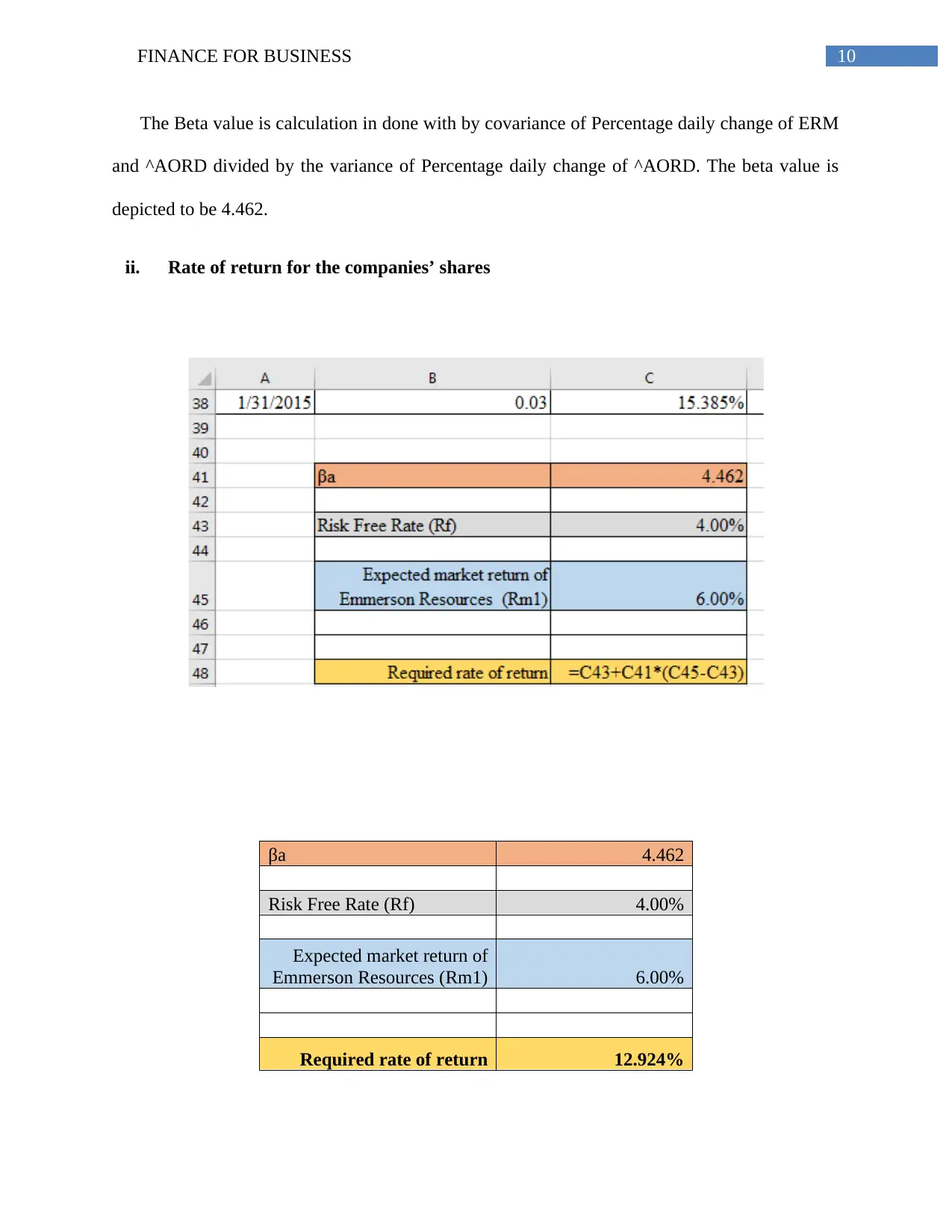
10FINANCE FOR BUSINESS
The Beta value is calculation in done with by covariance of Percentage daily change of ERM
and ^AORD divided by the variance of Percentage daily change of ^AORD. The beta value is
depicted to be 4.462.
ii. Rate of return for the companies’ shares
βa 4.462
Risk Free Rate (Rf) 4.00%
Expected market return of
Emmerson Resources (Rm1) 6.00%
Required rate of return 12.924%
The Beta value is calculation in done with by covariance of Percentage daily change of ERM
and ^AORD divided by the variance of Percentage daily change of ^AORD. The beta value is
depicted to be 4.462.
ii. Rate of return for the companies’ shares
βa 4.462
Risk Free Rate (Rf) 4.00%
Expected market return of
Emmerson Resources (Rm1) 6.00%
Required rate of return 12.924%

11FINANCE FOR BUSINESS
iii. Rationale for conservative investment
Despite of having a high rate of return (12.924%) in compare to the risk-free rate
of 4% and excepted market rate of 6%, the investment decision needs to considered with
several other factors. This is mainly depicted with consecutive looses accounted in the
last four years and decreasing trend of return on equity. The high Beta of 4.462 shows the
company is more prone to fluctuate with the share price index.
7. Weighted Average Cost of Capital (WACC)
i. WACC Calculation
Re Cost of equity
Rd Cost of debt
Equity
Market value of the firm’s
equity
Debt
Market value of the firm’s
debt
E/V
Percentage of financing that
is equity
D/V
Percentage of financing that
is debt
TC Corporate tax rate
Re 13%
Rd 6%
Equity 18787369
Debt 2730372
E/V 0.873111
D/V 0.126889342
TC 30%
WACC 11.82%
iii. Rationale for conservative investment
Despite of having a high rate of return (12.924%) in compare to the risk-free rate
of 4% and excepted market rate of 6%, the investment decision needs to considered with
several other factors. This is mainly depicted with consecutive looses accounted in the
last four years and decreasing trend of return on equity. The high Beta of 4.462 shows the
company is more prone to fluctuate with the share price index.
7. Weighted Average Cost of Capital (WACC)
i. WACC Calculation
Re Cost of equity
Rd Cost of debt
Equity
Market value of the firm’s
equity
Debt
Market value of the firm’s
debt
E/V
Percentage of financing that
is equity
D/V
Percentage of financing that
is debt
TC Corporate tax rate
Re 13%
Rd 6%
Equity 18787369
Debt 2730372
E/V 0.873111
D/V 0.126889342
TC 30%
WACC 11.82%
⊘ This is a preview!⊘
Do you want full access?
Subscribe today to unlock all pages.

Trusted by 1+ million students worldwide
1 out of 17
Related Documents
Your All-in-One AI-Powered Toolkit for Academic Success.
+13062052269
info@desklib.com
Available 24*7 on WhatsApp / Email
![[object Object]](/_next/static/media/star-bottom.7253800d.svg)
Unlock your academic potential
Copyright © 2020–2025 A2Z Services. All Rights Reserved. Developed and managed by ZUCOL.





